This is the eighth post in my series of biographical vignettes of the ladies who signed an 1882 Autograph book I found at a flea market. The young women were classmates at St. Mary’s Academy, a boarding school for girls on the campus of Notre Dame in South Bend, Indiana.
Margaret Fishburn signed the autograph book as Maggie, which is how I will refer to her. She also signed her surname with an ‘e’ at the end, but I didn’t find any documents with that spelling. Maybe she just preferred it that way and chose to write it as such.
Maggie was born in Will County, lIllinois on March 13, 1865. In 1860, the family lived south of Joliet in Jackson, Illinois, which no longer exists as a town. In 1870, they lived in Bird’s Bridge. That area is now within the city limits of Channahon. A vestige of the old place name survives in Bird’s Bridge Road adjacent to a bridge over the Des Plaines River. Maggie signed the book indicating Joliet as her hometown. There is an 1877 city directory entry for the family as living in Joliet on 2nd Avenue opposite the fairgrounds. They moved around within the same county for a couple of decades.
Daniel Fishburn and his wife Ellen, née Burson, had five children: George Washington, John Eugene, Warren Perry, Margaret, and Rosella. Maggie’s father was born in 1832 in Licking County, Ohio to a farming family. He continued in that occupation in Illinois quite successfully. Ellen Burson was born in 1840, also in Ohio. The couple were able to very comfortably retire to southern California where they lived until they died, Daniel in 1900 and Ellen in 1924. Daniel is buried in Rosedale Cemetery. Ellen’s services were managed by Pierce Brothers of North Hollywood.
I couldn’t find documentation for exactly when Maggie departed for St. Mary’s Academy. She was still living in Joliet in 1879 because she appears in a December 26 Joliet Sun newspaper article about a masque ball fundraiser held by the Citizens Corps (they raised $60). Where she was when the June of 1880 census was conducted, I’m not sure. She is not listed among the students at St. Mary’s on the census of that year, but neither is she noted with her immediate family members, uncles, or aunts.
In June of 1880, her parents and two siblings, Warren and Rosella, were living in Webb City, Missouri in the household of Daniel’s brother Uriah. An article in the April 11, 1882 Joliet Signal congratulated Daniel on the immense success of his zinc and lead mines in the twin cities of Webb and Carter (now Carterville), which it says are of “the richest in the United States and appear inexhaustible.” Also, “Five thousand men are employed about the mines.”

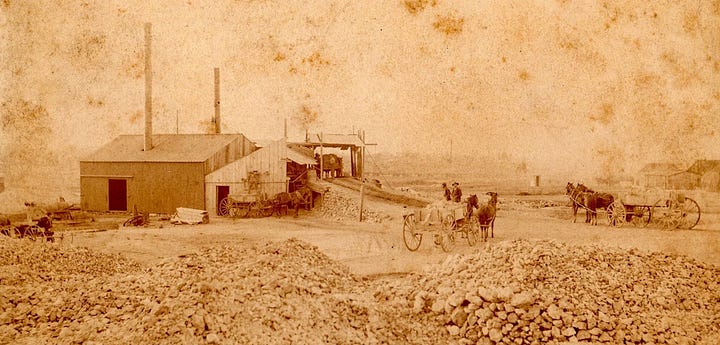
News articles sometimes exaggerate so I did some research on these claims. While Webb City’s population in 1882 was only 1,588, Carter City was much more populous at 12,000, so the claim that the mines employed 5,000 is plausible, especially in view of the richness of their ore. According to the Webb City Area Genealogical Society, those “mining fields were the richest mining lands found in the United States and were more valuable than the gold mines in the Klondike or the Black Hills of South Dakota,” with the value of the ore in 1904 being equivalent to $135,000,000 today. The Fishburn family seemed to be doing well enough beforehand, but this certainly secured their family’s financial status for the remainder of their lives and for their descendants. A small park in Webb City is dedicated to the mining industry there.


On a side note, Webb City is where the Buckfoot Gang set up shop in the following decade. I’ve written the first portion of the Buckfoot story here on Substack.
The close of 1879 was the last time the Fishburn family all lived together. In 1880, they had spread out across three states. Maggie’s brother Eugene, 21, is living on his own in Joliet as a bookkeeper. Her brother George, 23, is working as a clerk in a grocery store in Kansas City, Missouri. The owner, with whom he was living, may have been a family friend or relative. Joliet to Kansas City is a long move to make for work in a grocery unless it is for someone known to the family. By 1883, George was a bookkeeper for the Bank of Kansas City. He rose through the ranks in the industry through the ensuing years, starting a multi-generational family tradition of banking.
It’s possible, if not probable, with the family scattered, this was when Maggie entered St. Mary’s Academy and, in the process, missed being counted on the census in either Joliet or South Bend. The Academy students are listed together on the census and I’ve checked through it several times but don’t see a name that could be Maggie. I contacted St. Mary’s College (its current name) regarding possible historic enrollment information but have not heard back from them as of this writing. It’s also possible she was temporarily living with friends or other family members and her name was not accurately recorded.
Maggie married Charles Lyman Bisbee on December 10, 1896. By then, the Fishburn family had been living in San Diego for several years because Maggie’s marriage announcement says she is well known and respected for her charity work as well as a leader in San Diego society. Charles was working for the California Sash and Door Company.
The ceremony took place at Daniel and Ellen Fishburn’s home on Second Street in San Diego. The San Francisco Call & Post described the home as filled with elaborate floral decorations of smilax, potted palms, and various cut flowers. The couple was married in a bay window beneath a canopy of smilax. The newlyweds’ were to reside at 903 South Olive Street in Los Angeles. If the street numbering is the same, that location is now a newer building, the Parkside Apartments. Maggie and Charles must not have lived on Olive Street for long, because in 1900 they are living with her brother Eugene on Menlo Avenue.
This is a photo of S. Olive Street in 1885, taken between 4th and 5th streets, so about 4-1/2 blocks from their home. There were some absolutely gorgeous homes on Olive, including the Crocker Mansion which was in the 300 block in the area known as Bunker Hill. The house was razed in June of 1908 and the hill has been almost completely leveled. It’s hard to believe this was in what is now downtown Los Angeles.
The Bisbee’s were very social and often appeared in the Los Angeles Times society pages. In 1899, Charles attended the Los Angeles Horse Show as one of the prominent society attendees and box holders. Maggie and Charles were members of the L.A. Whist Club. Whist is a card game similar to, but less complex than, Bridge, and is played with partner pairs. The Whist Club nights were more elaborate than today’s poker or canasta nights. The homes where the gatherings were held are described in a similar fashion as weddings, profusely decorated with sweet peas and ferns, elaborate table decorations, and expensive attire. One 1912 example from the home of Mr. and Mrs. Edward Hobert on Oneonta Drive describes the home as having been turned into a bower of roses: American Beauty roses filled the drawing room and a mound of yellow roses graced the dinner table.
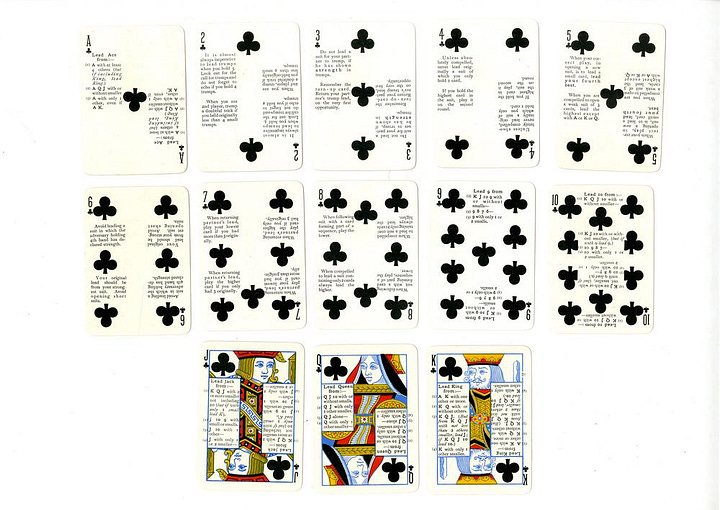
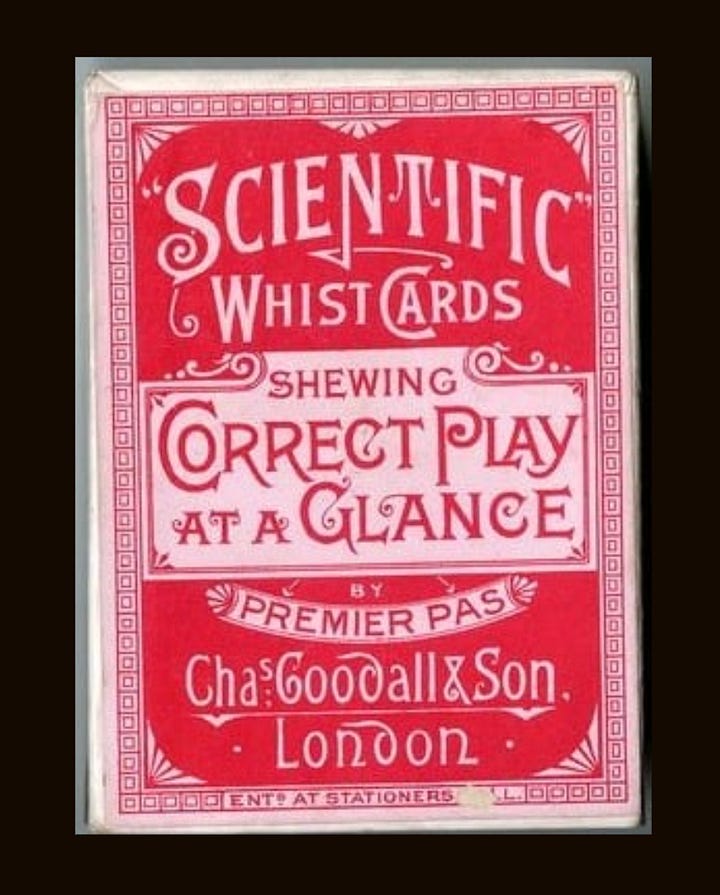
Over the years, Maggie was reported in attendance at china showers (like baby showers but for weddings), children’s groups, luncheons, society parties, and lush après theater galas. The Los Angeles Times described one of these soirées from 1913. Following entertainment at the Orpheum Theatre, the group removed to the Alexandria Hotel for a lavish meal. The dining table was decorated with a silver candelabrum with green shades around which were banked jonquils and violets. Lavender streamers of tulle fabric flowed from the flowers to each lady’s plate. Once the guests were in place, the hostess, Mrs. Wilson, gave a signal at which attendants produced corsage bouquets for the guests.

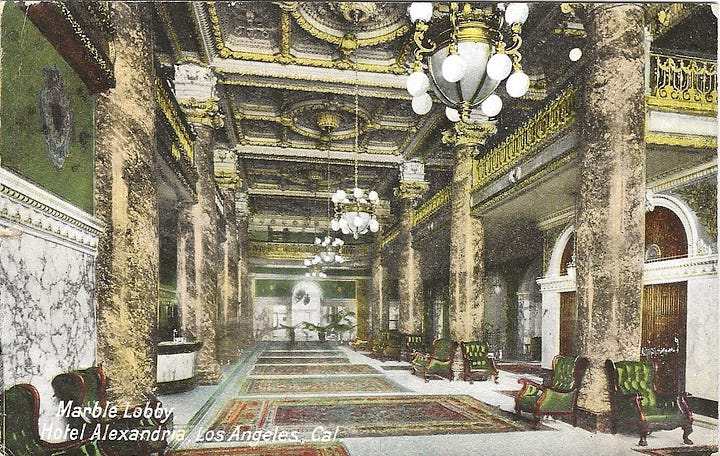
According to the L.A. Morning Tribune, in 1914, Maggie performed a vocal solo at a meeting of The Browning Club. The club met in honor of Robert Browning, a poet/playwright born in 1812 in London. He wrote a 12-book poem titled The Ring and the Book, a tale of a Roman murder trial, but was most famous for his poem The Pied Piper of Hamlin. He was widely acknowledged as a philosopher and was the husband of Elizabeth Barrett Browning.
Maggie and Charles had no children. The 1900 census specifies how many children have been born to a woman and how many survive and it documented zero children for Maggie. Over the years, no children were documented in the household or mentioned in obituaries.
In 1910, the couple lived just south of Sunset Boulevard next door to Maggie’s youngest brother Warren, his wife, Mabel, and their three children. In 1920, the Bisbee’s had moved to LaSalle Street and the household included Maggie’s mother, Ellen, and Warren, whose life was in utter turmoil at the time, which I’ll get to.
The last address for Maggie and Charles was on Edris Drive in Beverly Hills in 1930 and 1940. Charles died on October 5, 1945 and Maggie followed him three months later on January 29, 1946.
Eldest brother George Fishburn remained in the banking industry after his start in Kansas City. His listing in the 1914 city directory for San Diego states his occupation as President of the Marine National Bank. He and his wife, Ollie, had four children. A 1915 motor vehicle registration shows George registered a luxury car, a Pierce-Arrow 48B 60.5 Hp Traveling Car at a registration cost of $30, about $950 today.
John Eugene Fishburn was Vice President of a Los Angeles bank in 1900, and in 1910 was President of the Bank of California. In 1924, he was Chairman of the Board of Merchants National Bank. His son, John ‘Jack’ Fishburn, would become Vice President of the Bank of America headquarters. I don’t know what Eugene’s personality was like later in life, but I wonder if he ever laughed with his friends about any youthful mischief. For example, March of 1880, the Joliet Morning News reported that Eugene and a friend, Joseph McRoberts, were “fooling around” with a pair of old handcuffs. They got them on but couldn’t get them off. A locksmith had to be called to make a key. It didn’t say how long the friends were cuffed together. Eugene died on May 8, 1929. His funeral and burial were at Little Chapel of the Flowers at Forest Lawn Cemetery. He and his wife, Gertrude, had two children.
Warren started out in California as a salesman for a sash & door company (maybe on a referral from Charles Bisbee) and later is noted as co-owner of the Fishburn-Cross Coal Company as well as a real estate agent later in life.
In 1921, an article in the Los Angeles Evening Express printed an article about Warren and his wife Mabel. It reports that Mabel asked Warren to leave their home and then told him she despised him. By then, their children were adults. This is when Warren moved in with Maggie and Charles. When Warren sought a divorce from Judge Walton Wood, he told him he’d already arranged to give his wife $100 per month but Mabel had written him asking for an increase to $125 per month to which he agreed. The judge asked Warren why he so easily agreed to this. Warren replied that he knew Mabel wanted to pursue her literary interests and that if she didn’t get the money from him, she would have to work and he didn’t want to see her do that.
Mabel’s literary interests are mentioned with regularity in the Los Angeles papers at least as far back as 1912. Mabel was the Curator of the Galpin Shakespeare Club and taught Shakespeare classes for teachers each year. Warren died February 8, 1926 in Los Angeles.
Rosella married Isaac Polhamus in May of 1897. Isaac was clearly successful as a salesman for the American Lock and Door Company; their home on 24th Street in Los Angeles was valued at $30,000 in 1930, around $575,000 today. They had one child, a daughter named Margaret after her Aunt. Isaac preceded Rosella in death on February 10, 1941. Rosella died February 2, 1957. The last sibling of the family, Rosella lived in a lovely house atop a hill on Berry Drive, north of Laurel Canyon.







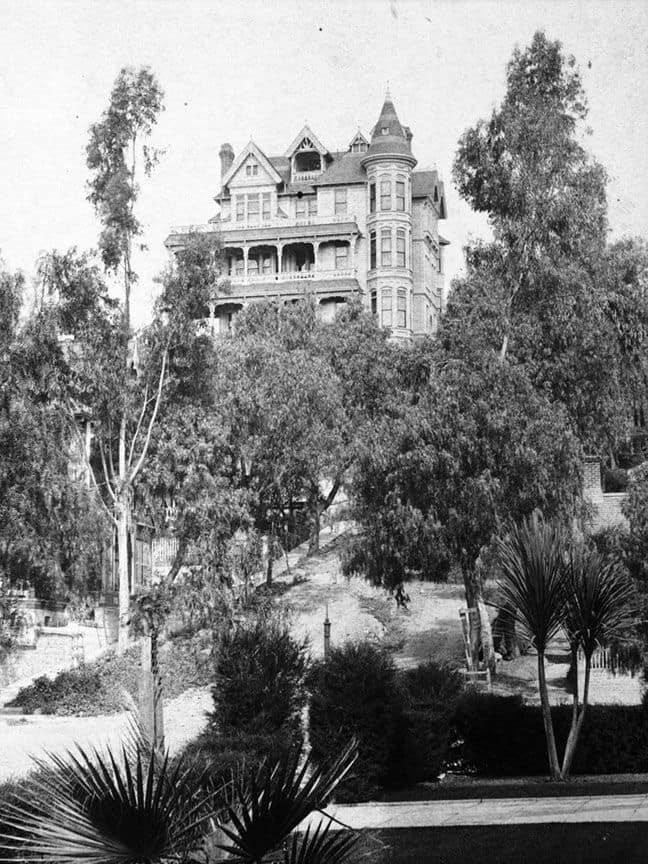



Another fascinating girl from the autograph book, and a great job a research in tracking her down! Taken as a whole, this project really covers a lot of the things going on at the time!
An unusual take on a "One Place Study" but it works quite well. Cynthia, I like your style of story telling, sprinkled heavily with lots of visuals and plenty of histo sprinkles.